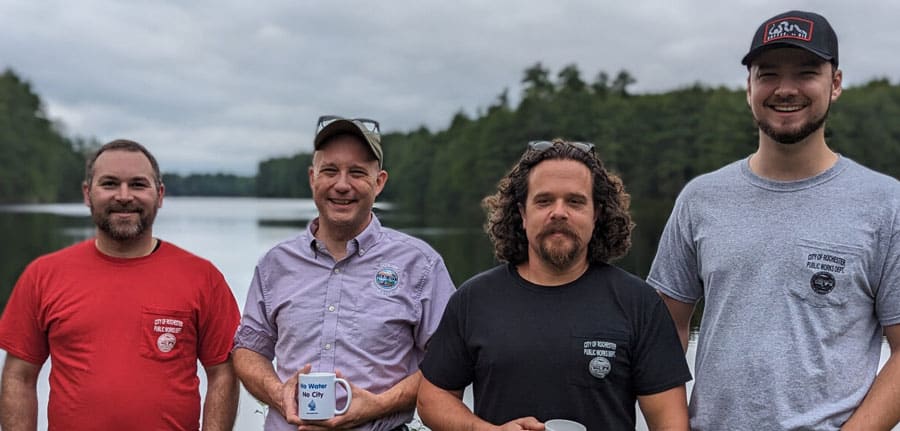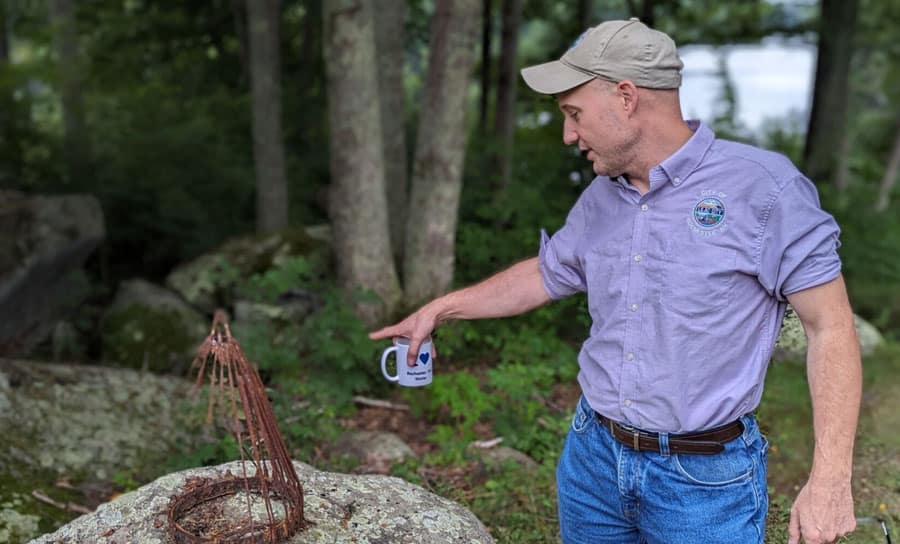Written and photographed by David Johnson
The Rochester Water Works team carries forward a legacy of conservation-powered, forward-thinking H20 protection and SELT is proud to partner with them on a journey that connects the past to the present – and ensures a future of clean water.
Ian Rohrbacher is proud.
You can tell in the way he talks about the goings-on at the Rochester Water Treatment Plant, or when he fires off kudos to the crew who help him pull the levers, test the levels, and maintain the overall flow of day-to-day water delivery. As the Water System Superintendent for the City of Rochester, Ian – along with his incredible team – has one of the most important responsibilities there is. (You could easily make the argument that there’s no more important job in civilization.)
“We have a saying,” he says. “No water, no city.”
Water plant operators are like offensive linemen in the NFL. You’ll rarely notice them when they’re doing their job, and the offense is humming, and water is clean and plentiful. But when the quarterback is plastered at midfield or what comes out of your kitchen faucet has the consistency of steak sauce, well, it’s a full-blown crisis.
“As a superintendent, I have a statutory obligation of being the primary operator,” he says. “A primary operator is responsible for the entire public water utility, from source to tap, storage protection, treatment delivery, and all that good stuff.”
“Good stuff” is doing a lot of heavy lifting here. The sheer amount of science and vigilance required to ensure a) water pours out when the handle is turned and b) drinking said water won’t make you violently ill, is more than a vocation.
“It’s a lifestyle,” Ian says. “The system can never shut down. As staff, we enjoy our jobs. We are invested in it and see ourselves as servants and leaders.”
The Water Works crew stand guard at the Rochester Reservoir. Left to right: Dan Proulx, Ian Rohrbacher, Zeke Lapierre, and Caleb Schag.
That leadership is laced into the DNA of Ian’s forebearers, the hydro jockeys from the Rochester of yesteryear who have been ahead of the curve for over 150 years.
“Back in 1870, there was no treatment needed because the water was so clean,” Ian says. “All they had to do back then was to screen the eels and the turtles out and let the water go right into the system.”
Things are just a bit more advanced now. The control center looks like something you’d find on the bridge of the USS Enterprise, which makes sense when your apparatus is responsible for keeping a community of over 33,000 people hydrated, cooled off, and healthy. With responsibility as hefty as that, you’d expect the tech to measure up.
But this is a secret sauce to what makes Rochester’s water protection legacy so renowned: and it’s about as analog as it gets. Dirt. And branches and roots and shrubs. Basically, all the forest contours that make up the wild topography surrounding Rochester’s most important water supplies – the watershed that filters the rainfall and runoff that recharge the reservoirs.
“Basically, we have a series of cascading reservoirs that were set up a century ago,” Ian says. “The water flows from the upper watershed down to the Rochester Reservoir, where we pump it. That’s the trip water makes before it gets to the facility, traveling 6 through all these channels and mixing and filtering on the way down.”
Protecting this precious land was how the Rochester water crew from days gone by kept the H20 clean. This approach has been carried out through the last 100+ years, putting the Lilac City at the forefront of the conservation/ clean-water calculus. What about the next 100 years?
For a growing municipality like Rochester (the city’s population has expanded 10 percent over the last ten years), scouting for the future water supplies is just as important as treating what is currently there. Identifying potential wellheads, looking at lands that abut untapped water bodies – all this activity and investment are designed to future-proof the city for looming aqua-needs. And that’s where SELT comes in.
As one of Rochester’s go-to conservation partners, SELT and its conservation team have been active over the years identifying and conserving high value parcels of land that lie within current – and future – watersheds.
All this activity and investment are designed to future-proof the city for looming aqua-needs. And that’s where SELT comes in.
“Having an organization like SELT that’s able to make the conservation pieces fit is great,” Ian says. “They help us leverage projects so it’s not just the water department that wants it. We can say that ‘this is a great opportunity because the landowner wants to conserve it or maybe there are trails on it. But this land will also protect future utilities downstream.”
As recently as last year, SELT worked with the City of Rochester to conserve two important properties, permanently protecting more than 70 acres along the Salmon Falls River, an important regional water supply. These properties connect with two other lands conserved by SELT, forming a daisy chain of watershed protection. All said, the Rochester/SELT relationship has led to over 350 acres of conserved lands to support the city’s current drinking water operation – and its future.
Outside of the rear entrance of the Rochester Water Treatment Plant sits a spindly, oxidized thingamajig, mounted on a slab of concrete, in an apparent place of prominence. What is this hunk of junk that apparently deserves such reverence?
“That is an original upper intake screen for the Berry River from the 19th century,” Ian says. An oxidized oddity to some. To others, like Ian, it’s a monument to prescient clean water delivery, historic H20 engineering, and an evergreen truth: no water, no city."
Ian Rohrbacher points to an original upper intake screen from the 19th century, an important artifact in Rochester Water Works history.


